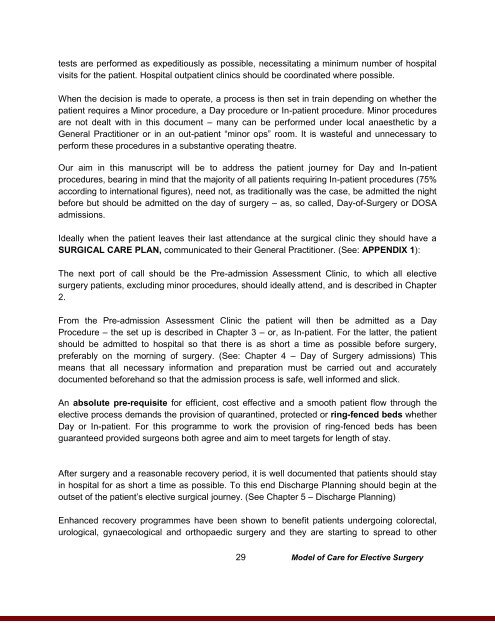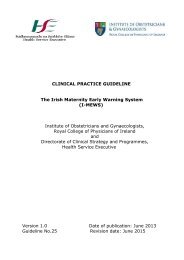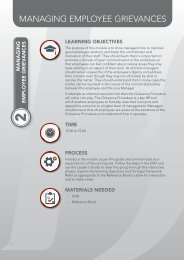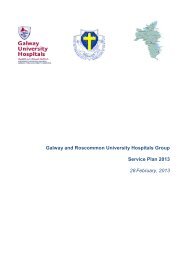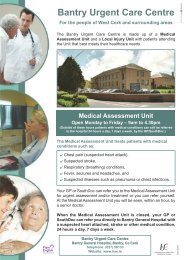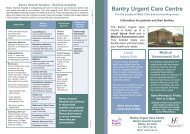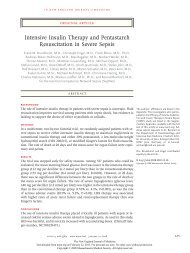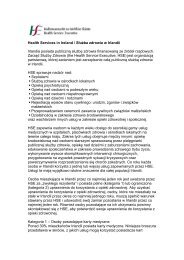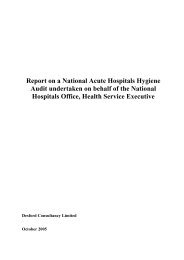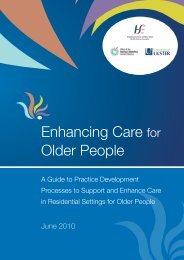Elective Surgery Programme Implementation Support Guide
Elective Surgery Programme Implementation Support Guide
Elective Surgery Programme Implementation Support Guide
You also want an ePaper? Increase the reach of your titles
YUMPU automatically turns print PDFs into web optimized ePapers that Google loves.
tests are performed as expeditiously as possible, necessitating a minimum number of hospital<br />
visits for the patient. Hospital outpatient clinics should be coordinated where possible.<br />
When the decision is made to operate, a process is then set in train depending on whether the<br />
patient requires a Minor procedure, a Day procedure or In-patient procedure. Minor procedures<br />
are not dealt with in this document – many can be performed under local anaesthetic by a<br />
General Practitioner or in an out-patient “minor ops” room. It is wasteful and unnecessary to<br />
perform these procedures in a substantive operating theatre.<br />
Our aim in this manuscript will be to address the patient journey for Day and In-patient<br />
procedures, bearing in mind that the majority of all patients requiring In-patient procedures (75%<br />
according to international figures), need not, as traditionally was the case, be admitted the night<br />
before but should be admitted on the day of surgery – as, so called, Day-of-<strong>Surgery</strong> or DOSA<br />
admissions.<br />
Ideally when the patient leaves their last attendance at the surgical clinic they should have a<br />
SURGICAL CARE PLAN, communicated to their General Practitioner. (See: APPENDIX 1):<br />
The next port of call should be the Pre-admission Assessment Clinic, to which all elective<br />
surgery patients, excluding minor procedures, should ideally attend, and is described in Chapter<br />
2.<br />
From the Pre-admission Assessment Clinic the patient will then be admitted as a Day<br />
Procedure – the set up is described in Chapter 3 – or, as In-patient. For the latter, the patient<br />
should be admitted to hospital so that there is as short a time as possible before surgery,<br />
preferably on the morning of surgery. (See: Chapter 4 – Day of <strong>Surgery</strong> admissions) This<br />
means that all necessary information and preparation must be carried out and accurately<br />
documented beforehand so that the admission process is safe, well informed and slick.<br />
An absolute pre-requisite for efficient, cost effective and a smooth patient flow through the<br />
elective process demands the provision of quarantined, protected or ring-fenced beds whether<br />
Day or In-patient. For this programme to work the provision of ring-fenced beds has been<br />
guaranteed provided surgeons both agree and aim to meet targets for length of stay.<br />
After surgery and a reasonable recovery period, it is well documented that patients should stay<br />
in hospital for as short a time as possible. To this end Discharge Planning should begin at the<br />
outset of the patient‟s elective surgical journey. (See Chapter 5 – Discharge Planning)<br />
Enhanced recovery programmes have been shown to benefit patients undergoing colorectal,<br />
urological, gynaecological and orthopaedic surgery and they are starting to spread to other<br />
29 Model of Care for <strong>Elective</strong> <strong>Surgery</strong>


